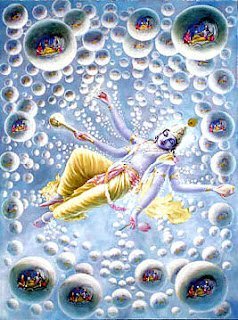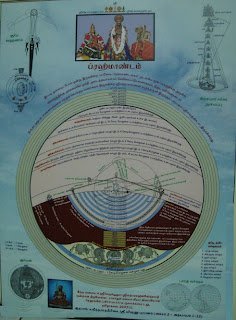sri:
srimathE rAmAnujAya nama:
srimadh varavaramunayE nama:
sri vAnAchala mahAmunayE nama:
This article can be viewed as a presentation by clicking https://docs.google.com/presentation/d/188gzTl_qZKtyIxiwKguIjBSkxH-9t9zUw_U98YJGbkk/present#slide=id.p.

srimathE rAmAnujAya nama:
srimadh varavaramunayE nama:
sri vAnAchala mahAmunayE nama:
This article can be viewed as a presentation by clicking https://docs.google.com/presentation/d/188gzTl_qZKtyIxiwKguIjBSkxH-9t9zUw_U98YJGbkk/present#slide=id.p.
- In the previous article (https://granthams.koyil.org/2013/03/06/thathva-thrayam-chith-who-am-i/), we observed the nature of chith thathvam (Soul).
- We are continuing our journey in understanding the three entities (chith, achith, Iswara) through the divine grantham “thathva thrayam” (tattva trayam) of piLLai lOkAchAryar with the help of maNavALa mAmunigaL‘s beautiful commentary.
Understanding the achith (matter) thathvam through the teachings of the wise men
We are continuing our journey in understanding the
three entities (chith, achith, ISwara) through the divine
grantham “thathva thrayam” (tattva trayam) of piLLai lOkAchAryar with the
help of maNavALa mAmunigaL‘s
beautiful commentary.
three entities (chith, achith, ISwara) through the divine
grantham “thathva thrayam” (tattva trayam) of piLLai lOkAchAryar with the
help of maNavALa mAmunigaL‘s
beautiful commentary.
Introduction
- achith
(insentient) is devoid of knowledge and is abode for
change/transformation. - Since,
achith is devoid of knowledge, it purely exists for the enjoyment of
others. - Unlike chith (sentient – soul), which is unchangeable (does not change its
nature), achith undergoes changes. - There
are three types of achith, namely- sudhdha
sathvam – pure goodness devoid of any rajas (passion) and thamas
(ignorance) - miSra
sathvam – combination of sathvam (goodness), rajas (passion) and thamas
(ignorance) - sathva
sUnyam (kAlam) – The principle of time which is devoid of any guNam
(sathvam, rajas, thamas)
- sudhdha
sudhdha sathvam (pure goodness)

paramapadham
– spiritual abode of SrIman nArAyaNan which is full of mandapams, gardens,
etc., which are made of divine matter
– spiritual abode of SrIman nArAyaNan which is full of mandapams, gardens,
etc., which are made of divine matter
- This is pure goodness devoid of any rajas and
thamas. This is mainly focussed on all achith (insentients) in
paramapadham.
- By nature, this
-
- is eternal
- is source of knowledge and joy
- manifests as vimAnams/gOpurams (towers),
mandapams (halls), etc by the divine desire of bhagavAn instead of being created by the desire of a jIvAthmA induced by his karmA. - is in an unlimited brilliantly shining
form - cannot be quantified/fully comprehended
by nithyas (eternally free from samsAram), mukthas (one who became
free from samsAram) and bhagavAn himself. mAmunigaL raises a doubt and clarifies it himself – if bhagavAn cannot
quantify/fully comprehend this, would it not affect his sarvagyathvam –
omniscience (knower of everything)? He beautifully explains that knower
of everything means knowing the true nature of everything – so, bhagavAn knows that sudhdha sathvam is unlimited which is its true nature
and that is true omniscience. - is exceedingly marvellous
- Some say that, this is luminous and others say
that is this is non-luminous. There are two opinions about it.
- But there is more weightage for the view that
it is luminous. In such case, it will reveal itself to nithyas, mukthas
and bhagavAn. But samsAris will be unable to perceive it. - It is different from the soul since
- it does not realize itself
- it transforms into many forms
- It is different from knowledge since
- it manifests into different forms (knowledge
does not take any gross form) without the help of others - unlike knowledge which grasps thanmAthras
(objects of senses – sound, touch, form, taste and smell), this is abode
of the subtle elements.
- it manifests into different forms (knowledge
miSra
sathvam (impure goodness)
sathvam (impure goodness)
- By nature, this is
- a mixture of sathvam, rajas and thamas
- a veil which blocks the jIvAthmA from
realising full knowledge and bliss - the source of perverse knowledge for the
jIvAthmAs - eternal
- an instrument for ISwaran in his pastimes
- at times
similar to each other and at other times different from each other
depending on state (avyaktha – unmanifested state vs vyaktha – manifested
state) and time (srushti – creation vs samhAram – destruction time) - popularly known as
- prakruthi – since it is the source of all
changes - avidhya – since it is tangential to true
knowledge - mAyA – since
its outcome is marvellous and full of different varieties
- prakruthi – since it is the source of all
- As identified by nammAzhwAr in thiruvAimozhi 10.7.10, there are 24 elements of matter, namely
- pancha thanmAthras – 5 objects of senses –
Sabdha (sound), sparSa (touch), rUpa (form), rasa (taste), gandha (smell) - pancha gyAnEndhriyas – 5 sense organs of
knowledge -srOthra (ears), thvak (skin), chakshur (eyes), jihvA (tongue),
grAhNa (nose) - pancha karmEndhriyas – 5 sense organs of
actions – vAk (mouth), pANi (hands), pAdha (legs), pAyu (excretory
organs), upastha (organs for procreation) - pancha bhUthas – 5 great elements – AkASa
(ether), vAyu(air), agni (fire), Apa/jala (water), prthvi (earth) - manas – mind
- ahankAram – ego
- mahAn – manifested state of matter
- mUla prakruthi – unmanifested state of matter
- pancha thanmAthras – 5 objects of senses –
- Of these, mUla prakruthi is the primordial
matter which manifests itself into various states due to the mixture of
guNams (attributes) - guNams are of three categories – sathvam
(goodness), rajas (passion) and thamas (ignorance) - sathvam is the inducer/source of happiness and
pleasure - rajas is the inducer/source of attachment and
thirst for material aspirations - thamas is the inducer/source of perverse knowledge,
forgetfulness, lethargy/laziness and sleep - When the 3 guNams are equally distributed,
that results in unmanifested state of matter. - When they are unequally distributed, that
results in manifested state of matter. - mahAn is the first state of manifested matter.
- ahankAram comes into existence from mahAn.
- Subsequently all the other elements
(thanmAthras, gyAna indhriyas, karma indhriyas, etc) manifest from mahAn
and ahankAram. - pancha thanmAthras (objects of senses) are the
subtle state of pancha bhUthas (gross elements) - bhagavAn creates the manifested universes by mixing these different
elements. - bhagavAn creates the universes (effect) and
their cause. i.e.,transforms the unmanifested mUla prakruthi into the
manifested state of elements by his sankalpam (effortlessly). - All entities which live in the universes are
created by bhagavAn through other living entities such as brahmA,
prajApathi et al (by guiding them being their antharyAmi – in-dwelling
super-soul) - Innumerable universes exist.

- They are created simultaneously and
effortlessly by bhagavAn just by his sankalpam. - Each universe has 14 layers. mAmunigaL explains in great detail about the structure of the universe based
on various pramANams.

Structure
of leela vibhUthi (samsAram – material world)
of leela vibhUthi (samsAram – material world)
- 7 bottom layers
- From the top, they are named – athalam,
vithalam, nithalam, kapasthimath (thalAthalam), mahAthalam, suthalam and
pAthAlam these are occupied by demoniac people, snakes, birds, etc - there are many beautiful towers, palaces, etc
which are more enjoyable than even svarga lOkam
- From the top, they are named – athalam,
- 7 top layers
- bhU lOkam – where humans, animals, birds, etc
live. Split into 7 large dhvIpams (islands). We are living in
jambhUdhvIpam. - bhuvar lOkam – where gandharvas (celestial
singers) live - svarga lOkam – where indhran (a post which is
to manage the activities of bhUlOkam, bhuvar lOkam and svarga lOkam) and
his associates live - mahar lOkam – where the retired indhrans and
the ones who desire/waiting to be indhran live - janar lOkam – where many great sages like
brahmA’s 4 sons sanaka, sanakAdhika, sanAthana and sanandhana, etc live - thapa lOkam – where prajApathis (primordial
progenitors) live
- bhU lOkam – where humans, animals, birds, etc
- sathya lOkam – where brahmA, vishNu and Siva
and their devotees live Each universe (made of 14 layers) is surrounded by
7 layers of protection – water, fire, air, ether, ahankAram, mahAn and
finally by mUla prakruthi. - gyAnEndhriyas acquire knowledge about subtle
and gross elements. karmEndhriyas
are used in performing various physical actions. Mind is common to all and
helps in
every aspect.

- panchIkaraNam is the process by which bhagavAn
mixes the various elements and leads to the manifestation of the universe
as we see it now.
sathva sUnyam – kAlam (time)
- By nature, time
- acts like a catalyst in the tranformation of
matter (from unmanifested state to manifested state and subsequently as
well). - manifests in different scales of measurement
(like day, week, fortnight, etc). - is eternal – meaning there is no beginning or
end for time - helps ISwaran in his pastimes
- is also a form (body) of emperumAn himself
- acts like a catalyst in the tranformation of
- mAmunigaL quotes naduvil thiruvEdhip piLLai bhattar who explained
classification of time into many parts.- nimEsham (moment, winking of the eye – equal
to a second) is the lowest unit of time - 15 nimEshams = 1 kAshta
- 30 kAshta = 1 kalai
- 30 kalais = 1 muhurtham
- 30 muhurthams = 1 dhivasam (1 day)
- 30 dhivasams = 2 pakshams (fortnights) = 1
mAsam (month) - 2 mAsams = 1 ruthu (season)
- 3 ruthus = 1 ayanam (6 months – uttarAyanam
and dhakshiNAyanam) - 2 ayanams = 1 samvathsaram (year)
- 360 human samvathsaram = 1 dhEva samvathsaram
- nimEsham (moment, winking of the eye – equal
- Other two achith thathvams (sudhdha sathvam
and miSra sathvam) are the enjoyable items, abode of enjoyment and
instrument of enjoyment. - sudhdha sathvam (divine matter) is boundless
at the top/sides and bounded at the bottom (it is fully present in
paramapadham – the higher/spiritual universes) - misra sathvam (matter) is boundless at the
bottom/sides and bounded at the top (it is fully present in samsAram – the
lower/material universes) - kAla thathvam is present everywhere (both in
paramapadham and samsAram). - It is said that time is permanent/eternal in
paramapadham and temporary/transient in samsAram. mAmunigaL quotes periyavAchAn piLLai‘s explaination – “time is of uniform (eternal) nature in both
paramapadham and samsAram” in his thathva thraya vivaraNam (a
grantham which is not to be found these days). So, that is considered as
the ultimate authority. But since some AchAryas have explained the
difference in nature of time between paramapadham and samsAram – it has to
be understood that because of its ever changing nature in samsAram, it is
considered as temporary here. - Some say time does not exist. But since it
defies logic and SAsthramm that cannot be accepted.
Conclusion
Thus we have seen a bit about the achith
(matter) thathvam which falls under 3 categories (sudhdha sathvam –
divine matter in paramapadham, misra sathvam – matter in this samsAram and
sathva sUnyam – time, common to both places). As said before, this
subject matter is very complex and this article is aimed at creating interest
to hear this subject matter under an AchAryan in the form of kAlakshEpam for
true enlightenment.
srImathE ramyajAmAthru munIndhrAya mahAthmanE
srIrangavAsinE bhUyAth nithyasrI nithya mangaLAm
mangaLAsAsana parai: madhAchArya purOgamai:
sarvaischa pUrvai: AchAryai satkruthAyAsthu mangaLam
Up next, We will see in detail about Iswara thathvam (God).
adiyen sarathy ramanuja dasan
Sources: thathva thrayamarchived in https://granthams.koyil.org, also visit https://acharyas.koyil.org

In hindi: https://granthams.koyil.org/2016/07/17/thathva-thrayam-chith-what-is-matter/
In thamizh – https://granthams.koyil.org/2017/10/06/thathva-thrayam-achith-what-is-matter-tamil/
In telugu – https://granthams.koyil.org/2019/04/18/thathva-thrayam-achith-what-is-matter-telugu/
In kannada – https://granthams.koyil.org/2022/01/02/thathva-thrayam-achith-what-is-matter/